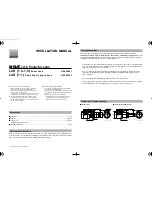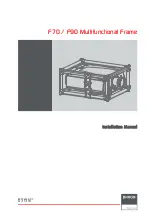
Hercules-EBX CPU User Manual V1.02
Page 13
The PC/104+ bus is essentially identical to the PCI Bus except for the physical design. It specifies
a single pin and socket connector for the bus signals. A 120-pin header J3, arranged as 4 30-pin
rows, incorporates a full 32-bit, 33MHz PCI Bus. The additional pins on the PC/104+ connectors
are used as ground or key pins. The female sockets on the top of the board enable stacking
another PC/104+ board on top of the board. The Hercules-EBX board should be the bottom board
of a PC/104+ stackup.
In the pinout figures above, the top corresponds to the left edge of the connector when the board
is viewed from the primary side (side with the CPU chip and the female end of the PC/104+
connector) and the board is oriented so that the PC/104 connectors are along the bottom edge of
the board and the PC/104+ connector is in the center of the Hercules-EBX board.
NOTE:
The PCI board interface is designed to allow different voltage-levels for the signaling interface.
The problem to be avoided in defining a keying mechanism within the specification was to prevent
a 3.3V-only device which is not 5V tolerant from receiving signals that are at a 5V signal rail. In a
standard PCI interface, this is handled by blocking a portion of the edge connector such that the
female connector is keyed as either “3.3V” or “5V”. The intention in doing this was to provide a
way to prevent a 3.3V-only card in a 5V system. Many vendors chose to implement a “universal”
edge connector that could fit into either configuration – this was typically done in one of two ways:
1) Use 3.3V signaling that is 5V-tolerant; or
2) Use the VIO pins on the PCI edge connector to power the I/O drive circuitry (or the
maximum voltage overshoot protection circuitry) on the card.
From a system perspective, the primary question is: which standard can you support? Many card
vendors chose to implement a specific standard (such as “5V only”) and then connect the VIO
signals to the internal power rail (such as “5V”) signals on the PCI edge connector. While this is a
violation of the more recent PCI specification, it was also relatively common, especially for card
developers who began developing PCI cards before the standard was updated for 3.3V support.
On the Hercules-EBX, all of the PCI circuitry is driven with 3.3V circuitry, but all of the circuitry is
5V tolerant. Given this, the Hercules-EBX main board can support either 3.3V or 5V-only cards.
For this reason, the connector is not keyed (to prevent one or the other types of cards from being
inserted). Rather, the main EBX board allows you to select which I/O voltage to use for a given
PC/104+ card (or set of cards).
Many PC/104+ cards are universal, in which case the voltage setting will not matter (provided
that it is set to either 3.3V or 5V). For cards that have a definite requirement, make sure that the
VIO jumper is set to the appropriate position. See page 36 for the details on this setting.
As per the specification, a 5V-only card can be recognized by the keying postion at location A1
(they have male pin A1 cut and female location A1 should be blocked).
Similarly, cards that are to have 3.3V power should have pin D30 cut (and female location D30
plugged).
Cards without either keying mechanism should be “universal” and should work with either I/O
voltage provided.
DO NOT MIX cards that have different I/O keying requirements (i.e., do not stack a card that has
pin A1 cut with a card that has pin D30 cut).














































